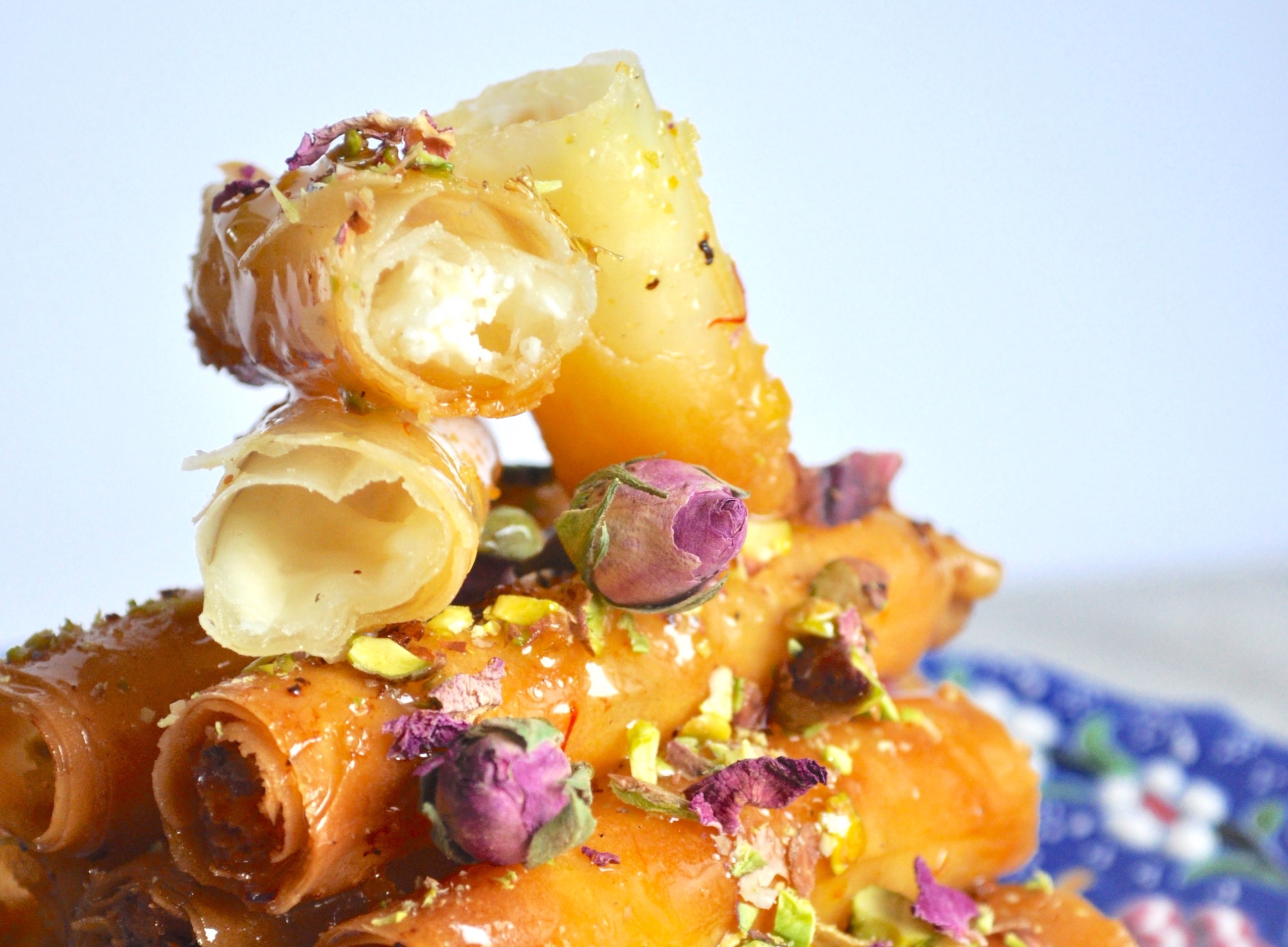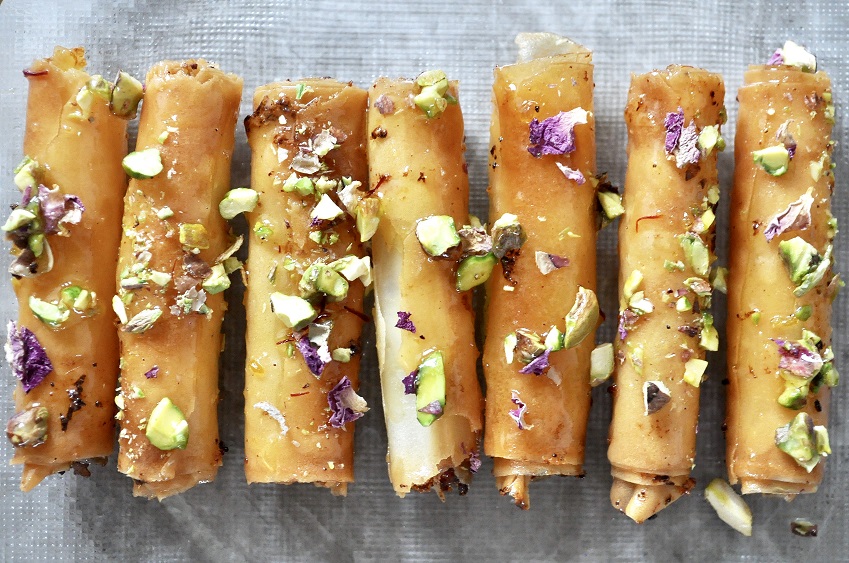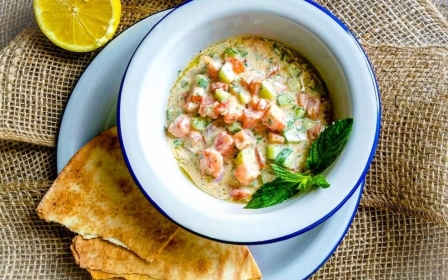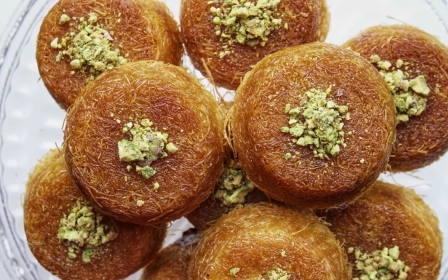How to make asabe zainab, a deep-fried pastry from Oman

Asabe zainab, which translates as "Zainab’s fingers", is a traditional Middle Eastern pastry dessert typically eaten during Ramadan.
While some Levantine countries make their version with semolina and leave out the filling, in Oman we wrap a creamy-based cheese in filo pastry, deep fry it, then finish it off by soaking it in a rich saffron and cardamom syrup. Something similar is made in Palestine, where it goes by the great name of znoud el sit ("forearms of the lady").
Despite the Ramadan link, Zainab herself was not known to be religious: legend has it that she made these sweet delicacies, which look like fingers, more than 100 years ago, sharing them out among her village. Neighbours and others were so impressed by their beauty that they eventually became known as Zainab’s fingers.
During Ramadan, there is not one of my aunties who will not have these at the table as an after-iftar treat. Growing up, I always wondered why we didn’t have them more often (and wished that we did). But my mother always reminded me that if we had them every day, then we would no longer be grateful for Zainab’s gift to us, and so Ramadan held onto that spirit of gratitude.
New MEE newsletter: Jerusalem Dispatch
Sign up to get the latest insights and analysis on Israel-Palestine, alongside Turkey Unpacked and other MEE newsletters
As I grew older, I would join the women of my family in making hundreds of fingers. But while I was quick to eat them, I was not so fast when it came to rolling and sealing the pastry. I remember my grandmother always telling me not to overstuff the fingers with cheese and only to use a little. "The cheese is like your knuckle, it is small and in the middle of your finger," she would say.
Learning the method made me appreciate why we save asabe zainab for Ramadan and the odd special occasion, as well as being thankful to Zainab for how she brought families together for generations to come.
In Oman, asabe zainab are traditionally made with cream cheese but I prefer to use ricotta and mozzarella, which combine a creamy texture and melted cheese when you eat them fresh.
The best part about this recipe is that it lets you make both the syrup and the fingers in advance. The pastries will also last up to a month in the freezer: perfect throughout Ramadan so you can easily whip out just enough to fry each evening. The syrup will also keep for up to two weeks if stored in an air-tight glass container.
Recipe
Makes: 30 pieces
Preparation time: 20 minutes
1. Ingredients
For the pastry fingers
- 30 rectangle sheets of filo or samosa pastry
- 125g (4oz) mozzarella cheese
- 125g (4oz) ricotta cheese
- 1tsp ground cardamom
- 1l (4 cups) of vegetable frying oil
- 2 tbsp of flour mixed with 1 tbsp water to form a paste
For the sugar syrup
- 450g (2 cups) of caster sugar
- 250 ml (1 cup) of water
- a good pinch of saffron strands
- half of a fresh lemon
- 3 cardamom pods
- a thermometer is helpful if you have one
2. Method
The syrup
- Begin by making the sugar syrup (you’ll need this to be cold by the time it comes to frying the pastry).
- In a saucepan, combine all the syrup ingredients and place on a high heat.
- Keep stirring till the syrup starts boiling.
- Reduce the temperature to a medium to low heat for a further 10 minutes, until all the sugar has dissolved and the syrup has become slightly golden and thicker. If you are using a thermometer, you are looking for a temperature of 110°C (230°F).
- Remove the syrup from the heat and allow it to cool at room temperature.
For the pastry fingers
- Shred the mozzarella into tiny pieces and then combine them with the ricotta and the ground cardamom.
- Mix it all together and place to one side.
- Separate the pastry sheets and keep them wrapped in a damp cloth to ensure that they don’t dry out.
To roll the fingers
- Take one sheet of pastry and place about ¾ tsp of the cheese mixture at the bottom (leave a slight edge to grab the pastry).
- Make sure your cheese is in the centre, otherwise some of it may escape when it comes to rolling the pastry.
- To begin the roll, first turn both corners into the middle to form a triangle (as if you are about to create a paper airplane, see below) so that the cheese is covered.
- Next, carefully take the bottom corner of the triangle and fold it over tightly. Then continue to roll all the way to the top.
- When you get to the top, leave a slight edge. Take your finger, dip it into the flour paste, rub it along the end part of your pastry and seal it across. This will ensure that the fingers don’t unravel when they are frying.
- Repeat the steps above for the rest of the fingers.
Frying the fingers
- When using filo or samosa pastry you’ll need to fry from cold to hot oil. This ensures that all the layers come out crispy and also retain their crispiness.
- Fill a medium sized wok or sauce with oil (don't use a big pan as you want the oil to be deep).
- Place all the fingers inside the oil and then turn the heat up high.
- Once the fingers begin to brown, reduce the heat slightly to ensure that they cook evenly. Keep turning them until they are completely golden.
- As soon as they are ready, turn them onto some kitchen roll to soak up excess oil.
- Then carefully drop them into the syrup and mix until they are fully coated.
- Serve straight away for the best bites.
You can follow Dina on her Instagram at @dinewithdina, Facebook or www.dinewithdina.co.uk
This article is available in French on Middle East Eye French edition.
Middle East Eye delivers independent and unrivalled coverage and analysis of the Middle East, North Africa and beyond. To learn more about republishing this content and the associated fees, please fill out this form. More about MEE can be found here.









